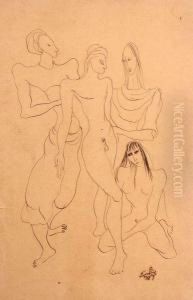Emile Piot Paintings
Émile Piot was a French academic painter and illustrator whose work spanned the second half of the 19th century and the early 20th century. Born on August 6, 1840, in Paris, France, Piot developed an early interest in the arts, which was nurtured in the culturally rich environment of Paris. He received his formal education at the École des Beaux-Arts, where he studied under renowned artists of the time. Piot was particularly influenced by the classical and academic traditions of painting, which is reflected in his meticulous technique and the choice of subjects that often harked back to historical, mythological, and allegorical themes.
Throughout his career, Piot exhibited his works at various prestigious venues, including the Paris Salon, where he gained recognition for his talent and skill in painting. His artworks were characterized by their detailed precision, vibrant colors, and the ability to convey deep emotional expressions and narratives. Piot's paintings often depicted scenes from ancient history and mythology, bringing to life the stories of Greek and Roman gods and heroes with a romantic sensibility that was typical of the period.
In addition to his contributions to painting, Émile Piot was also known for his work as an illustrator. He provided illustrations for several books and periodicals of his time, allowing his artworks to reach a broader audience. Piot's illustrations were highly regarded for their clarity, attention to detail, and the ability to complement and enhance the narrative of the texts they accompanied.
Piot's artistry was not confined to historical and mythological paintings; he also explored portraits and landscapes, showcasing his versatility as an artist. Despite the changing art movements towards the end of the 19th century and the rise of Impressionism and Post-Impressionism, Piot remained committed to the academic style of painting, emphasizing beauty, technique, and narrative.
Émile Piot passed away on December 1916, in Paris, leaving behind a legacy that has contributed to the understanding and appreciation of French academic art of the late 19th century. Though perhaps not as widely recognized today as some of his contemporaries, Piot's work continues to be admired for its technical prowess and its evocative portrayal of historical and mythological subjects.

